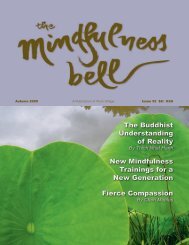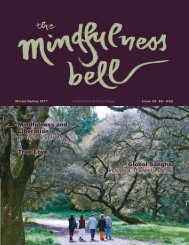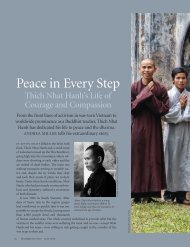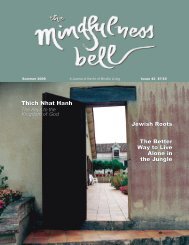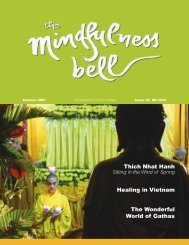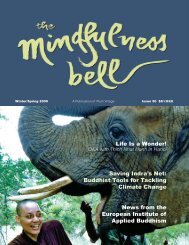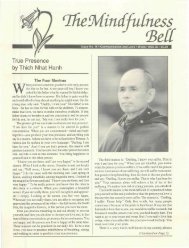View full issue in PDF - The Mindfulness Bell
View full issue in PDF - The Mindfulness Bell
View full issue in PDF - The Mindfulness Bell
You also want an ePaper? Increase the reach of your titles
YUMPU automatically turns print PDFs into web optimized ePapers that Google loves.
(such as medical<br />
hardship) provided that<br />
l 9 9 6<br />
the chairperson of the<br />
Order and the local or<br />
most appropriate<br />
Dharma teachers are<br />
first consulted and, if<br />
time permits, the local<br />
or most appropriate core<br />
community members.<br />
4) <strong>The</strong> charter's<br />
exist<strong>in</strong>g description of<br />
the extended community<br />
should be reta<strong>in</strong>ed,<br />
but it should emphasize that long-stand<strong>in</strong>g members of the<br />
extended community (i.e., those who have participated<br />
regularly for a year or more) should be consulted about<br />
potential ord<strong>in</strong>ations, whether or not that member has taken<br />
the Five M<strong>in</strong>dfulness Tra<strong>in</strong><strong>in</strong>gs.<br />
5) While the charter may cont<strong>in</strong>ue to state that partners<br />
of an Order member should be members of either the core or<br />
extended community, it is proposed that language be added<br />
stat<strong>in</strong>g that, <strong>in</strong> the alternative, an aspirant would live<br />
harmoniously with his or her partner so that the aspirant's<br />
partner supports his or her practice.<br />
Youth and Family Practice<br />
<strong>The</strong> Youth and Family Practice group was a wonderful<br />
meadow of beautiful smil<strong>in</strong>g flowers. We listened to each<br />
other deeply as we promised to have fun and to work from<br />
our own experiences rather than theory. We discussed the<br />
challenges to practice with youth. We recognized that<br />
sometimes children suffer rather than enjoy children's<br />
programs on retreats. We encouraged each other to listen<br />
deeply to children and to look deeply at ourselves so that we<br />
might make creative growth experiences out of opportunities<br />
that arise. Our purpose statement embodies that vision:<br />
We recognize the joy of m<strong>in</strong>dfulness practice with<br />
children, families, and communities. We want to embrace<br />
the spark of children's enthusiasm. Through the practice of<br />
look<strong>in</strong>g through children's eyes and <strong>in</strong>to their hearts, we<br />
wish to provide lov<strong>in</strong>g opportunities for them to creatively<br />
explore the Dharma. We recognize the challenge of <strong>in</strong>clud<strong>in</strong>g<br />
children <strong>in</strong> our practice. We wish to share with each<br />
other our diverse experiences of practice. We honor the<br />
value of diversity and acknowledge the need for skillful<br />
means to make the Dharma available to children of different<br />
backgrounds. <strong>The</strong>refore, to encourage an experientiallybased<br />
approach and to nourish the seeds of m<strong>in</strong>dfulness, we<br />
envision these tools for practic<strong>in</strong>g with children:<br />
o A family section <strong>in</strong> <strong>The</strong> M<strong>in</strong>dfulness <strong>Bell</strong>, composed of<br />
an "adults" page, with anecdotal experiences, suggestions<br />
~ OT practice, seasonal practices, and family retreat <strong>in</strong>formation,<br />
and a children's page with children's writ<strong>in</strong>gs and<br />
draw<strong>in</strong>gs.<br />
o A resource notebook which would serve as a family<br />
practice handbook. <strong>The</strong> notebook could be composed, <strong>in</strong><br />
part, from Thay's Dhanna talks and from the family section<br />
of <strong>The</strong> M<strong>in</strong>dfulness <strong>Bell</strong>.<br />
o Cassettes and videotapes (fun and <strong>in</strong>structional), some<br />
prepared by young people on retreat and some prepared for<br />
youth and children <strong>in</strong> practice.<br />
o Mak<strong>in</strong>g Thay's Dhanna talks for children more widely<br />
available <strong>in</strong> tapes or transcripts.<br />
o Support for local family retreats through notice of<br />
retreats, shar<strong>in</strong>g experience of what does and does not work<br />
<strong>in</strong> local Sanghas, and help<strong>in</strong>g to organize family retreats.<br />
o A catalog of resources on practice with children,<br />
compiled by members of the Youth and Family Council<br />
with contributions from the larger Sangha.<br />
Sangha Build<strong>in</strong>g<br />
<strong>The</strong> role and responsibility of Order of Interbe<strong>in</strong>g members<br />
is to practice, to offer practice, and to support other people<br />
<strong>in</strong> the practice. <strong>The</strong> follow<strong>in</strong>g recommendations were made:<br />
I) Help Jack Lawlor revise the draft of the manual on<br />
start<strong>in</strong>g a Sangha.<br />
2) Support Dharma teachers to lead retreats with<strong>in</strong> and<br />
outside their geographic areas. Assist newer groups and<br />
<strong>in</strong>dividuals to organize these retreats.<br />
3) Commit ourselves to practic<strong>in</strong>g consensus, Beg<strong>in</strong>n<strong>in</strong>g<br />
Anew, and the Peace Treaty <strong>in</strong> our Sanghas, and deepen<strong>in</strong>g<br />
our Sangha relationships. Create a suggestion box as a way<br />
for newer people to offer their fresh perspective to the<br />
Sangha.<br />
4) Commit ourselves to develop shared leadership by<br />
teach<strong>in</strong>g our skills and develop<strong>in</strong>g ourselves <strong>in</strong> less skilled<br />
areas, honor<strong>in</strong>g different styles of approach<strong>in</strong>g the work.<br />
5) Ga<strong>in</strong> wisdom from elders. Help newer folks. Support<br />
and receive support from monks and nuns.<br />
6) Commit ourselves to look deeply at how our collective<br />
consciousness and <strong>in</strong>dividual experiences shape how we<br />
see differences between us, <strong>in</strong> order to understand and honor<br />
differences (e.g. cultural, ethnic, gender, sexual orientation,<br />
economic).<br />
7) Commit ourselves to help<strong>in</strong>g Sanghas solve problems.<br />
Enlist support of Dharma teachers and <strong>in</strong>ternational resources<br />
to help.<br />
19



